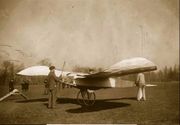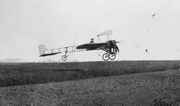Louis Blériot
| Louis Blériot | |
|---|---|
 |
|
| Born | 1 July 1872 Cambrai, France[1] |
| Died | 2 August 1936 (aged 64) Paris, France |
| Nationality | French |
| Occupation | Inventor and engineer |
| Known for | First complete heavier-than-air flight over a large body of water First working monoplane |
Louis Blériot (1 July 1872 – 2 August 1936) was a French aviator, inventor and engineer. In 1909 he completed the first flight across a large body of water in a heavier-than-air craft, when he crossed the English Channel. For this achievement, he received a prize of GB£1000 (5,000 dollars; US 1910).[2][3][4] He also is credited as the first person to make a working monoplane.[5] Blériot was a pioneer of the sport of air racing.
Contents |
Early years
_-_George_Grantham_Bain_collection.jpg)
Born in the village of Dehéries near Cambrai, Louis Blériot studied engineering at the École Centrale Paris. He invented automobile headlights and established a successful acetylene headlamp business, amassing a small fortune. He used the money from his business to experiment with towed gliders on the Seine River, learning about aircraft and flight dynamics.[6] His interest in aviation manifested itself when, in 1900, he built an ornithopter, which failed to take off.
Blériot and collaborator Gabriel Voisin formed the Blériot-Voisin Company. Active between 1903 and 1906, the company developed several unsuccessful and dangerous aircraft designs, which drained his finances. Blériot then left and started creating his own airplanes, experimenting with various configurations, eventually creating the world's first successful monoplane, the Blériot V, but this model crashed easily. However, by 1909, he created the Blériot XI, which was more stable.[7] Its first flight was on 23 January of that year, and later it was displayed at the Exposition de la Locomotion Aérienne in Paris in 1909.[5][8]
The Channel crossing


After years of honing his piloting skills, Blériot decided to try for the thousand-pound prize offered by the London Daily Mail for a successful crossing of the English Channel.
Blériot had two rivals for the prize, both of whom failed to complete the crossing. The first was Hubert Latham, a French national of English extraction. He was favoured by both the United Kingdom and France to win. He had arrived first and attempted the crossing on 19 July, but six miles (10 km) from his destination of Dover the Antoinette IV developed engine trouble and was forced to make the world's first landing of an aircraft on the sea.[9] The other pilot, Charles de Lambert, was a Russian aristocrat with French ancestry, and one of Wilbur Wright's students. However, Lambert was injured in a major crash during a test flight, forcing him to quit the competition. On July 25, 1909, the three rivals all arrived at the seaside town of Calais, France. Blériot had a badly burned foot, caused when a gasoline line broke on his #VIII machine during one of his trial runs. Despite this he did not withdraw.[7] The #VIII was Blériot's largest and most successful design before the #XI. After his crash in the #VIII which left him with the burnt foot, the #XI was the only other aircraft he had available to make the Channel flight.
The French government provided a destroyer to escort and observe his plane during the trip to Dover (Latham had already been rescued by the French torpedo-destroyer Harpon on the 19th July.[10]). Blériot used his own design, the Blériot XI, a structurally strong but simple and manoeuvrable monoplane. This was powered by a 25 horsepower, 3-cylinder Anzani radial engine with a 2-bladed fixed-pitch wooden propeller, the engine barely as powerful as a lower end large outboard motor as used on the rear of present day motorboats.[11][12] He took off at dawn, just after 4:30 AM on July 25, 1909. He later reported, in a telegram to the Washington Post, that he accelerated his engine to 1,200 revolutions per minute, almost its top speed, to clear telegraph wires at the edge of the cliff near the runway field. Then he reduced his speed to give the XI an average airspeed of approximately 40 miles per hour (64 kilometres per hour) at an altitude of about 250 feet (76 m). Soon after, inclement weather began to form, with the Channel becoming rougher. Blériot lost sight of any landmarks, and rapidly outpaced the destroyer escort. He stated: “[f]or more than 10 minutes I was alone, isolated, lost in the midst of the immense sea, and I did not see anything on the horizon or a single ship”.[4]
The landing was in turbulent weather, causing problems for Blériot: rain was cooling the engine, putting it in danger of stalling, and the strong wind was blowing him off course. As Blériot reduced his airspeed for the landing, the gusts of wind nearly caused his plane to crash from an altitude of 20 meters (67 feet), when he cut off the engine. The landing severely damaged his landing gear, along with the propeller. However, the rest of the aeroplane was in good order and the landing was deemed successful.[6]
He flew 22 statute miles (36.6 km) from Les Baraques (near Calais) to Dover.[8] The trip took 37 minutes and Blériot became an immediate celebrity. The Blériot Memorial, the outline of the aircraft laid out in granite setts in the turf, now marks his exact landing spot on the cliffs above Dover. .
Later life
Between 1909 and the outbreak of World War I in 1914, Blériot produced more than 800 aircraft, most of them variations of the Type XI model. However, the quality of the aircraft was controversial, as shown by inspections after several crashes. The British government put a temporary ban on them, until Blériot himself investigated and solved the problems that had caused the crashes.[13]
In 1913, a consortium led by Blériot bought the Société pour les Appareils Deperdussin airplane manufacturer and he became the president of the company in 1914. He renamed it the Société Pour L'Aviation et ses Dérivés (SPAD); this company would go on to manufacture fighter planes used in World War I, including the SPAD S.XIII.
He attempted to set up a British subsidiary through the Blériot Manufacturing Aircraft Company Ltd. in England in 1916. Its listing was hijacked by a dishonest syndicate headed by Harry John Lawson, leaving the company unable to meet its obligations, and it was soon wound up.[14] In 1917, Blériot tried again and built a factory in Addlestone, Great Britain. After the war, Blériot formed his own company, Blériot-Aéronautique, for the development of commercial aircraft, which was more successful than that founded by the Wright brothers.[5][8]
In the United States, there was a legal patent battle for the invention of the aileron between the Wrights and Blériot: Blériot's aeroplanes were selling very well, but the Wright brothers did not receive any royalties from him, even though this technology for controlling aircraft was clearly their invention. This was eventually recognized.[5]
Previously, Blériot had opened flying schools before World War I at Brooklands in Surrey, and Hendon Aerodromes.
In 1927 Blériot, long retired from flying, was present to welcome Charles Lindbergh when he landed at Le Bourget field completing his transatlantic flight. The two men, separated in age by thirty years, had each made history by crossing famous bodies of water. Together they participated in a famous photo opportunity in Paris.
In 1934, Blériot visited Newark Airport in New Jersey and predicted commercial overseas flights by 1938.[15]
Death
Blériot remained active in the aviation business until his death on August 2, 1936 in Paris, France of a heart attack.[16] He was interred in the Cimetière des Gonards in Versailles.
Legacy
In his honor, the Fédération Aéronautique Internationale established the "Louis Blériot medal" in 1936. The medal may be awarded up to three times a year to record setters in speed, altitude and distance categories in light aircraft, and is still being awarded.[17]
On 25 July 2009, the centenary of the original Channel crossing, Frenchman Edmond Salis took off from Blériot Beach in an exact replica of Bleriot's monoplane. He landed successfully in Kent at the Duke of York's Royal Military School.[18]
In popular culture

- In 2002, the English train company Virgin Trains introduced a new type of train called British Rail Class 221. One of these trains (number 221 101) was named Louis Blériot.
- In 2006, Rivendell Bicycle Works introduced a bicycle model named the "Bleriot 650B" as a tribute to Louis Blériot. It features his portrait on the seat tube.
See also
- First flying machine
- List of early flying machines
References
- ↑ Centennial of Flight, US government
- ↑ Blériot, Louis (1909-07-25). "Bleriot Tells of his Flight" (PDF). The New York Times. 1909-07-26. ISSN 0362-4331. OCLC 1645522. http://query.nytimes.com/mem/archive-free/pdf?_r=1&res=9907E2DE1F31E733A25755C2A9619C946897D6CF. Retrieved 2009-07-26. "I rose at 2:30 this (Sunday) morning, and, finding that the conditions were favorable, ordered the torpedo boat destroyer Escopette, which had been placed at my disposal by the French Government, to start. Then I went to the garage at Sangatte and found that the motor worked well."
- ↑ "The New Daily Mail Prizes" (PDF). Flight (London, U.K.: F. King and Co.) 5 (223): 393. 1913-04-05. ISSN 0015-3710. OCLC 6674288. http://www.flightglobal.com/pdfarchive/view/1913/1913%20-%200387.html. Retrieved 2009-07-25. "£1,000 for flight across the channel between England and France, to be accomplished in daylight without touching the sea. Offered on October 5th, 1908. Won by M. Blériot, July 25th, 1909 in 46 minutes of flight.".
- ↑ 4.0 4.1 Clark, Nicola (2009-07-24). "100 Years Later, Celebrating a Historic Flight in Europe". The New York Times. ISSN 0362-4331. OCLC 1645522. http://www.nytimes.com/2009/07/25/world/europe/25crossing.html. Retrieved 2009-07-25. "Mr. Blériot informed The Daily Mail of his intention to compete and set up his plane near the beach at Les Barraques. At 4:41 a.m. on July 25, in near-perfect weather conditions, Mr. Blériot took to the air, the plane’s engine belching clouds of black smoke. He skirted the French coastline and then veered north, flying about 30 yards above the water."
- ↑ 5.0 5.1 5.2 5.3 transportationhistory.suite101.com/article.cfm/louis_bleriot Transportation History at Suite101.com. Retrieved March 12, 2008.
- ↑ 6.0 6.1 An essay on Louis Blériot
- ↑ 7.0 7.1 PBS - Chasing the Sun - Louis Blériot
- ↑ 8.0 8.1 8.2 Spartacus School network article. Retrieved on March 12, 2008.
- ↑ Walsh, Barbara. Forgotten Aviator Hubert Latham pp. 93-97
- ↑ Walsh, Barbara. Forgotten Aviator Hubert Latham pp. 93-97
- ↑ "R/V Tautog". Small Vessel Fleet. University of Connecticut, Marine Sciences. http://www.marinesciences.uconn.edu/MSTC/Vesselops/rv_small.html. Retrieved 1 January 2010.
- ↑ Hawkins, A.D., Urquhart, G.G. & Shearer, W.M. "The coastal movements of returning Atlantic salmon, Salmo salar L." Scottish Fisheries Research Reports, Fisheries Research Services. January 1979. Accessed 1 January 2010.
- ↑ Encyclopaedia Britannica Online Encyclopedia article on Louis Blériot
- ↑ "Winding Up Of An Aircraft Company., In Re Blériot Manufacturing Aircraft Company (Limited)". The Times. 20 January 1916.
- ↑ "Inspects Newark Airport". New York Times. October 17, 1934. http://select.nytimes.com/gst/abstract.html?res=F70615FB35551B728DDDAE0994D8415B848FF1D3. Retrieved 2009-07-26. "Louis Bleriot Predicts Oversea Service Within Four Years."
- ↑ "Bleriot, First To Fly English Channel, Is Dead". Chicago Tribune. August 2, 1936. "Lindbergh of Day Victim of Heart Attack at 64. Louis Bleriot, 64, famous French aviator who first flew the English channel, died today. Bleriot, who became an engineer after his air career, ..."
- ↑ FAI Louis Blériot medal winner listing
- ↑ Centenary flight reprise.
External links
- US Centennial of Flight Commission: Louis Blériot
- Louis Charles-Joseph Blériot flight and plane information (photos and videos)
- A Daring Flight - Homepage to the NOVA TV episode
- 1909 Blériot XI at YouTube
- Dover 2009 Blériot-The Centennial
- Louis Blériot Memorial Behind Dover Castle UK
|
|||||
|
||||||||||||||